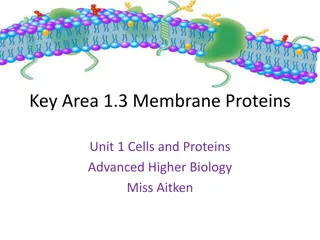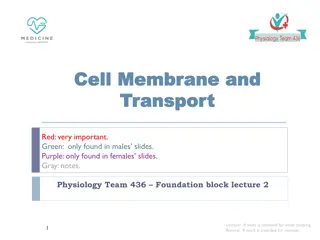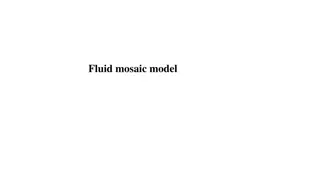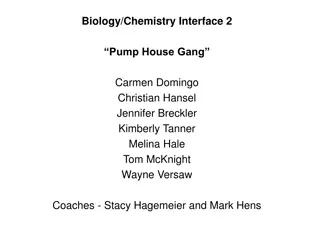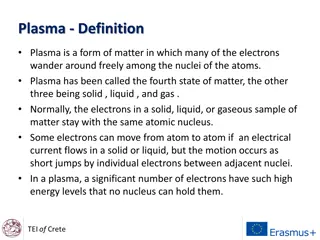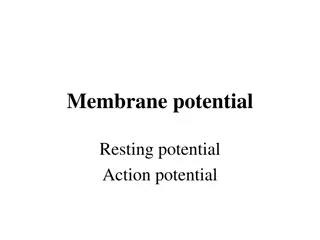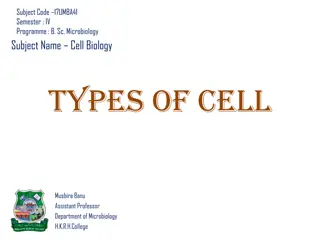The Plasma Membrane in Cells
The plasma membrane, a vital component of cells, is a thin, elastic, and selective barrier composed of proteins, lipids, and oligosaccharides. It facilitates communication with the external environment, regulates the passage of substances, and maintains cell integrity.
Download Presentation

Please find below an Image/Link to download the presentation.
The content on the website is provided AS IS for your information and personal use only. It may not be sold, licensed, or shared on other websites without obtaining consent from the author.If you encounter any issues during the download, it is possible that the publisher has removed the file from their server.
You are allowed to download the files provided on this website for personal or commercial use, subject to the condition that they are used lawfully. All files are the property of their respective owners.
The content on the website is provided AS IS for your information and personal use only. It may not be sold, licensed, or shared on other websites without obtaining consent from the author.
E N D
Presentation Transcript
Dr. Ananda Kumar Saha Dept. of Zoology Rajshahi University
The Outer surface of all Protoplast is to bounded by exceedingly thin (70-100 A0thick) , elastic, semipermeable, trilamilar, lipoprotenious, living limiting membrane, which separets the cellular protoplasm with their external environment. This membrane is called Cytoplasmic membrane, Cell membrane, Plasmalemma, or Plasma membrane. Modern Cytologist prefer the term (De Robertis, 1975) Plasma membrane.
Plasma membrane is present in most cell types and was the first membrane to develop during the evulation of living systems. The Plasma membrane does not constitute a totally inert barrier between the cell and its environment. It thus permits the selective uptake of the solvents, solutes and particles and secretion of waste products.
Chemical Composition The Plasma membrane is composed mainly of protein, lipid, and a small percentage (1-5%) of oligosaccharides that may be attached to either the lipids (glycolipids) or the proteins (glycoproteins).
The Plasma membrane contains about 20-79% of lipids. The Main lipid constituents are Phospholipids, Cholesterol, and Galactolipids. A lipid molecule basically consists of two parts, a head (glycerol) which is water soluble or hydrophilic and two tails (fatty acids ) which are water insoluble hydrophobic.
Protein represents one of the most significant fractions of Plasma membrane. They play an important role, not only in the mechanical structure of the membrane, but also carriers or channels, serving for transport.
About 30 enzymes have been reported from the plasma membrane. Adenyl Cyclase, Alkaline Phosphatase, RNAase etc. The enzymes Na+- K+ activated Mg+ ATPase is one of the most important enzyme of plasma membrane because of its role in ion transfer across the plasma membrane.
Bimolecular leaflet model of Danielli and Davson: Plasma membranes consist not only of lipid, as proposed by Overton, Gorter and Grendel but also of adsorbed protein. This conclusion, reached by Danielli and Davson in 1934, formed the basis of what is now known as the Danielli-Davson model or bimolecular leaflet model of membrane structure.
Danielli and Davson proposed that the Plasma membrane consists of (Phospholipid) molecules a bimolecular leaflet- formed in such a way that the polar or hydrophilic part of the lipid molecules are in contact with the surrounding aqueous hydrophobic or non-polar hydrocarbon portions are associated in the central region of the leaflet. The entire structure would consist of a double layer of lipid molecules sandwiched between two essentially continuous layers of protein. two layers of lipid phase, where as the
Robertson noticed that Plasma membrane of Prokaryotes and Eukaryotes and intracellular membranes from a wide variety of eukaryotes Cells appear under the electron microscope as three- layered (trilamilar) structures approximately 75-100 A0 in thickness. Robertson termed this structure a Unit membrane.
Another model of membrane structure was proposed by S. J. Singer and G. L. Nicolson in 1972 and has been widely accepted. envisioned cell membranes as mosaics of lipids and proteins. Membrane proteins are not fixed within the lipid bilayer but are free to move laterally, like icebergs floating submerged in a sea of lipid. Singer and Nicolson





